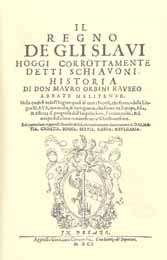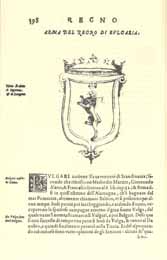AN UNIQUE EDITION IN THE BOOK-STOCK
OF „SAVA DOBROPLODNI” REGIONAL LIBRARY- SLIVEN
 On
May 11, the second day of
the
National Children's Book Festival, the publisher Damyan
Yakov
made a valuable donation to
“Sava
Dobroplodni”
regional library
- bibliophilic
phototype
edition of "The Kingdom of the Slavs”
by
Mavro
Orbini.
This unique edition
was
printed last year in
total print of
only 300 issues.
It
was
implemented
on
a project of Michael Belchev - Director of the Capital Library, which owns
the only original copy of the book in Bulgaria,
and publisher Damyan
Yakov,
with
the
financial support
of
the Ministry of Culture. In
handing
the donation Damyan
Yakov
announced that the book
was
not for sale. So far it has
been gifted
by the Prime Minister and
the
President in their official visits. Among the recipients
of the
precious gift
are Pope Benedict XVI, the Italian
Prime
minister,
the Mayor
of Moscow and others. Each copy of the book has a unique number.
Under
the number 8
in
the list of recipients
of the
valuable edition
is
Sliven Regional Library.
On
May 11, the second day of
the
National Children's Book Festival, the publisher Damyan
Yakov
made a valuable donation to
“Sava
Dobroplodni”
regional library
- bibliophilic
phototype
edition of "The Kingdom of the Slavs”
by
Mavro
Orbini.
This unique edition
was
printed last year in
total print of
only 300 issues.
It
was
implemented
on
a project of Michael Belchev - Director of the Capital Library, which owns
the only original copy of the book in Bulgaria,
and publisher Damyan
Yakov,
with
the
financial support
of
the Ministry of Culture. In
handing
the donation Damyan
Yakov
announced that the book
was
not for sale. So far it has
been gifted
by the Prime Minister and
the
President in their official visits. Among the recipients
of the
precious gift
are Pope Benedict XVI, the Italian
Prime
minister,
the Mayor
of Moscow and others. Each copy of the book has a unique number.
Under
the number 8
in
the list of recipients
of the
valuable edition
is
Sliven Regional Library.
The book was published in 1601 in Pezaro in Italian language and its original title, in the spirit of traditions at that time was the "Kingdom of the Slavs”, today incorrectly called skiavoni (i,e, slaves). A story by Don Mavro Orbini from Ragusa, Abbot of Mletski Order, which showed the origin of almost all nations, speaking Slavic languages with the many different wars that they fought in Europe, Asia and Africa, the progress of their kingdoms, their ancient religion and the time of their conversion to Christianity. And above all it described the success of the kings who once ruled in Dalmatia, Croatia, Bosnia, Serbia, Rashka and Bulgaria.
Anyone who has read from beginning to the end "The Kingdom of the Slavs” was charmed by the multifaceted text. Its readers are numerous: still in the original Italian language the book was expected in all monasteries of the Mletska Congregation of Benedictine where brother Mavro found a shelter on his way to libraries and archives; in the palaces of the Italian aristocracy, unlock trustfully its libraries because of the prestige of the patron-exile from Dubrovnik; but also because of personal love for books, awoken by the adventurous author's intent – his history to present as one whole the kingdom of Slavs from Eastern and Southeastern Europe.
Soon the book of Mavro Orbini was translated into Latin. This way it took its place on the library shelves in the language, that was an official language for the European science at that time and its impact can already be identified: in XVII century on the French Byzantine studies and Balkan studies; during the XVIII century on the Protestants-pietists in Saxony (Jena and Halle), in Austria (Pozhon, today Bratislava) ...
 The
compendium "Book historiography” was printed in Russian language in 1722 and
that made it accessible also for the Orthodox intelligentsia. Literate
Southern Slavs passed distances of a few days by foot until they reach where
they heard that they can find it.
The
compendium "Book historiography” was printed in Russian language in 1722 and
that made it accessible also for the Orthodox intelligentsia. Literate
Southern Slavs passed distances of a few days by foot until they reach where
they heard that they can find it.
Nowadays – extracts are available translated into Serbo-Croatian language, with a biography of the writer and with strictly scientific comments: “Kralyevstvo slovena”, 1968 (Franjo Barishich, Radovan Samardzic and Sima Cirkovic).
And also into Bulgarian – extracts too - in a separate book "The kingdom of the Slavs”, 1983 (Bozhan Hristov, Todor Sarafov and Nadezhda Dragova) with a facsimile application from the Russian edition in 1722 - the section on Bulgarian history, first used by Bulgarian historians. There is also a full Croatian izdanie/1999 /; translation Snejana Husich, introductory studios by Franjo Shaniek.
At the beginning of his book Orbini puts the description of Scandinavia - the cradle of Slavs in his opinion and according to many medieval historians, which he cites. This section, entitled "Origin of the Slavs and prosperity of their kingdom”, dominated the composition and one third from the book. It most strongly showed the consistent Orbini’s love for Slavs. There is something biblical, eternal and invariable in the described way of many centuries of Slavic nations, always paved by shining wins - from Scandinavia to Asia, to whole Europe and Africa.
And the fundamental: here really for the first time all Slavs have been named and their historical vestige on the Old continent has been highlighted- and not only of the major nations: Russians, Poles, Czechs, Slovaks, Bulgarians, Serbs, Croats, but also of small ones - Northern Serbs (nowadays called Sorbian or Lusatian) and Slovenes, about who in short (on four pages) a story about their battles and their conversion has been told.
The greatest admiration deserves the suggestion of Orbini, that the core of Slavic unity is their common Slavic characters and writing. There are samples of both Slavic alphabets given - the Glagolitic and Cyrillic, as well as names of letters. This book then played the role of Slavic literacy textbook.
Paying attention to all the Slavs in his next story, Orbini focused his attention only on the Balkans, about which he warned in the title of the book.
Before Mavro Orbini in European literature there was not a complete picture of Bulgaria. Orbini first wrote its story! It covered 77 pages (397-474) built visually, consistently followed and rationalized like an exemplary state system. So Regno Bulgaria in the first year of the XVII century held its prestigious place in the modern history of the universe.
Orbini treated in brief pagan time, because he wanted longer to occupy the interest of his readers with God-loving and noble deeds. Historical information about the legendary Sveropil / Svetopelek he derived from the Old Bulgarian passional of the Baptist Prince Boris-Mihail (lost nowadays); from the life of Kliment Ohridski (also unsaved for us); from many works from that time which we know. He dedicated documentary pages to state and church-building activities of Prince Boris Baptizer. He traced with vivid episodes also the fate of his sons who inherited him.
As a dissonance to the glorifying words in the book sounded the reproach to the Kingdom of Bulgaria at the end of the text – the edifying-critical conclusion here is the finale to the whole Bulgarian history. In the page’s margin brief instructions are exported – “glosses”, of which the latter was: "Note what civil disagreements brought! And the extensive text explained it: "This is really an excellent example of what can dissension and civil war bring. Because Bulgarians (according to Biondo, Sabelik and Platina) were the most powerful nation that can beat the Turkish force. And while they lived in agreement, neither one of their enemy, nor even all their enemies together, were able to conquer them. But after they parted because of their kings, their kingdom, which once was a thriving one, it completely collapsed. "
Before each story printed Orbini printed the state emblem of the described Kingdom, Principality, despot state or city-republic. The gilded stemmi on the gates and banners of the Dalmatian patricians, and also on the Slavic Catholic bishops were proof that the nobility in ancient Slavs was proved by a national emblem too. It was encouraged by Baroniy himself, who reported in his book that Bulgarians had as a sign on their royal seal a lion’s image. This lion’s image – crowned, exposed in a medallion, Orbini placed at the beginning of the historical chapter about the Kingdom of Bulgaria. The national emblem proved that the kingdom was solid and invincible!
Why Mavro Orbini’s story is so important for the Bulgarian history?
In1722 the book was translated into Russian and printed in St. Petersburg with the blessing of Emperor Peter the Great. The book was quickly brought to the Balkans, where its Russian translation made it accessible to the already numerous Slavic intelligentsia. It was supplied in the library of the Archbishopric in Sremski Karlovci (then Austria). There, in 1761 the first national Bulgarian historian - monk Paisii Hilendarski read it. In his effort to write Bulgarian history, he has collected historical material from the available for him Greek and Russian books, archives and notes in books in churches and monasteries. This was difficult for him because his data were fragmented and the lack of a skeleton did not allow him to bind them in order to fill his authentic notes. In many cases he needed to read a continuous story -events to stand in a broad vision. The Russian edition gave all this to him. In the few days, in which the monastery's management allowed him to stay in Sremski Karlovci, he copied the Bulgarian section and when he returned to Mount Athos, as early as next year - in 1762, he finished his book " Slavonic-Bulgarian History " / “Istoriya Slavyanobolgarskaya” /- a national manifesto of modern awareness.
The history of Paisii in script reached many readers, but also many voluntary copyists. Together they formed the spiritual movement of Historicism in the Bulgarian Revival. Six decades later, monks-taksidiots /traveling orthodox monks/ of the Rila Monastery of St. John re-composed it. They acquire a part of it (the prevalent one), but they assembled it with other fragments - not mechanically, but conceptually - as a recent for the mid-XIX century historical knowledge. Hristaki Pavlovich, a teacher in Svishtov (on Danube river), a previous graduate of Rila monastery, edited the Rila text that reached him, took the new title "Tsarstvenik” and published the story in Budim in 1844. This was the first printed edition of Paisii’s history and we did not find his name as its author. "Tsarstvenik or Bulgarian history, which taught from where Bulgarians came, as they had a Kingdom, as they had kings and how they destroyed they kingdom and fell under yoke. From Mavrobir Latin, Baron, Joanna Zonara, Buefira French, Teofana Greek, Holy Evtimii from Tarnovo, Holy Dimitar Rostovski and other chroniclers”.
The unique book will be available to readers of the regional library on a special regime of reading, valid for rare and valuable books.